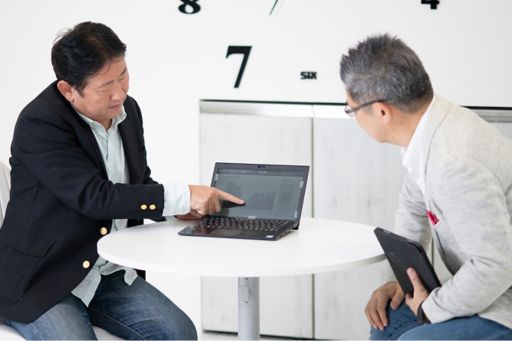Opportunities to actually experience the benefits and values derived from technology have been increasing in the past few months due to the impact of COVID-19. Among them, the most notable is people-flow data, which provide information we want to know right now such as “which locations are crowded now?”
People-flow data probably showed us a path to the use of big data, which we thought was valuable but could not find a definitive use. They must have also made executives desperately aware of the need to “transform to data-driven management.”
In this article, we will introduce the discussions conducted between Kazuhisa Shibayama, President and CEO of Agoop Corp., which provides such people-flow data, and Masayuki Chatani from KPMG Ignition Tokyo.
Contents
- What Challenges Did Agoop Face before Its People-flow Data Became Popular?
- Data Analysis Method Determines the Granularity of Information
- “Foreseeing” Demanded Data
- Reason Why Data Will Be Essential for Management Judgements after COVID-19
- Divergence between Data and Sentiment May Cloud Decision-making
- Good Time to Review Disaster Control Measures Based on Data
- Profile of Interviewee
What Challenges Did Agoop Face before Its People-flow Data Became Popular?

(Kazuhisa Shibayama, President and CEO of Agoop Corp. (left) and Masayuki Chatani, Representative Director & CEO of KPMG Ignition Tokyo and CDO of KPMG Japan) *Professional affiliation and official position in the article are at the time of publication.
Chatani: Since the issue of COVID-19 started to prevail, I have seen the name “Agoop” in various media and the term “people-flow data” has also become widely known. People-flow data are now sparking many discussions on the correctness and handling of approaches such as how to collect data, the validity of the data and their analysis.
I assume that Agoop had been exploring the use of big data including people-flow data from before the COVID-19 crisis, steadily accumulated experiences and dispatched them appropriately at the perfect time. Today, I invited Mr. Kazuhisa Shibayama to talk to us about the importance of data-driven management as well as his new findings based on his past experiences.
Shibayama: We have indeed been taken up by many media in the past few months. Regarding the disclosure of people-flow data, the Ministry of Internal Affairs and Communications approached KDDI, DoCoMo and Agoop in mid-February of this year, and as we were already preparing to carry out an analysis on COVID-19, we readily said “yes, we’ll do it!”
We had already launched various projects with the Ministry of Internal Affairs and Communications from about two years ago.
Projects included, for instance, utilizing people-flow data to visualize changes in the flow of people when remote working is implemented as part of the reform of working practices, in line with the holding of a global sport event, or the travelling directions and distances of foreign visitors to Japan, and then to think of how this can be leveraged for policymaking.
Agoop’s technology to acquire people-flow data utilizes skills we have been cultivating for quite some time.
As you well know, SoftBank has been making efforts to become the provider “with the No. 1 connection” since 2012. We knew that to realize this, it was more efficient to grasp the precise locations of “areas with bad connections” based on data and invest in facilities focusing on these areas.
For mobile phone companies, it goes without saying that the locations of base stations are quite important. However, it was essential to utilize data to grasp the best locations from the viewpoint of users.
The utilization of big data such as “computerizing data to be utilized for measures and policies” was a buzzword throughout the world between 2012 and 2013 but they had actually not been utilized specifically.
However, Masayoshi Son was already carrying out “data-driven management,” where everything was decided based on data, in 2012. Our current situation is that this method has finally become available at the country level.
Data Analysis Method Determines the Granularity of Information
Chatani: I hear that Agoop’s people-flow data are distinctively accurate, as it acquires precise information with GPS and statistically processes them by segmenting the areas with mesh processing. How exactly are you deriving the data?
Shibayama: There is a difference in acquiring precise location information via GPS and statistically processing data by segmenting the areas. We are creating analysis reports through statistical processing and mesh processing of location information acquired in real time with the prior consent of app users.
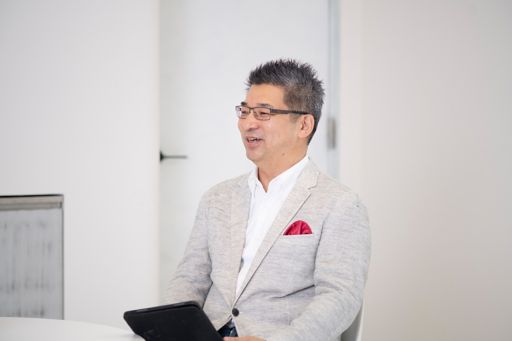
First of all, the amount of GPS data we are acquiring to provide statistical people-flow data is far less than the total population of approx. 120 million people, and the amount of data we can acquire at base stations is equivalent to the number of users of mobile phone companies (about 30-40 million people). Therefore, it is necessary to convert both data to those equivalent to the entire population.
At Agoop, we were initially presuming the distribution of approx. 120 million people from the granular location information acquired with precision. At this time, an immense amount of time and work occurred for the analysis. While these tasks are now streamlined by using RPA (robotic process automation) and AI, the workload used to be extremely heavy.
While our hypothetical/presumption algorithms have been refined through our initiatives with the Statistics Bureau of the Ministry of Internal Affairs and Communications since 2018, we came to understand that “data that can be acquired from each base station are accurate but coarse while data acquired from GPS are granular but small in volume,” both leaving concerns over their correctness.
Based on various comparative examinations, we found out that the increase and decrease in the flow of 120 million people can be obtained with just 1-2% data by incorporating the conversion population in the algorithm.
When we mesh process granular data, computation processes become very fast. However, considerable computer resources are necessary. Meanwhile, as the request from the Ministry of Internal Affairs and Communications was to “receive information every day,” we are employing a method to analyze the transition of people-flow after mesh processing the GPS location information.
As I mentioned earlier, I think we had a competitive advantage because we had already mostly established the scheme to obtain data more quickly through automation without human interference four years ago.
“Foreseeing” Demanded Data
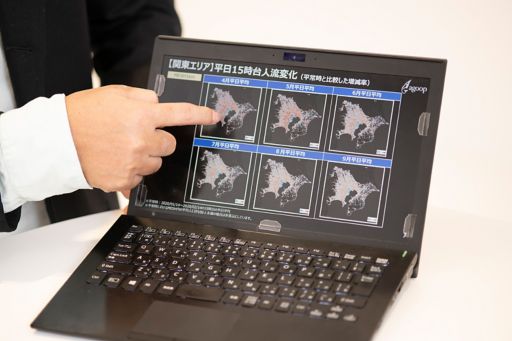
Shibayama: We were thinking of using these data for trading businesses three or four years ago but I think there were still only a few cases in Japan at the time that had achieved effective results by using analyzed data in management. We were therefore thinking that “only SoftBank or the central government would want to utilize this technology” when this COVID-19 crisis broke out.
Chatani: Looking at the graphs provided by Agoop on TV, I was greatly impressed by their accuracy, which showed the correlation between the number of newly infected cases in Shinjuku and Shibuya and the number in the previous week or information on the number of visitors to Arashiyama after the launch of GoTo Travel in real time.
I’m even more impressed that RPA and AI are utilized and that this technology had already been established three to four years ago.
Shibayama: The reason why Agoop can provide ample data compared to other companies is that we have been providing data under overwhelming pressure (laughs).
What I came to understand while working hard to respond to the requests of Mr. Son is the importance of “foreseeing the future.”
If we can foresee “what the media wants, what executives want, and what people want” based on the responsibility of a data scientist at the time when Silver Week (long weekend in autumn) is approaching, for example, we will be introduced in the media and this will become an opportunity to get more people to know about the advantages of data.
We have already established the technological aspects for indicating the people-flow data so what is important now, I think, is to foresee “social trends.” For example, we previously declared and actually provided people-flow data for areas which the media would want to know about right away after the Bon holidays. I think such efforts are important now.
Chatani: The comparison that young people were not hanging out in Shibuya and Shinjuku while there were many people in Sugamo was quite interesting.
Shibayama: Japan is a great country. When the heads of prefectures and communities send out strong messages, people respond to these messages and change their actions. Furthermore, young people must have voluntarily refrained from going out to the town as they were criticized for hanging out despite the COVID-19 crisis.
However, it is natural for people to be in Sugamo and Togoshi-ginza because these are places where the locals do their shopping. It was not our intention that some of the media misled viewers regardless of this fact.
So, we argued against it by putting data on Twitter and tried to communicate the correct information. The response on the web was that “as the data provider is saying that ‘the media is misleading people,’ it must be true.”
From spring up to the long holiday season in May, there were very few people during the day in Shinagawa, Shinbashi and Otemachi. So, those people must have been in the neighborhood of their homes, and it is natural that they would go out to the nearby supermarkets and shopping areas to buy things for their daily needs.
Reason Why Data Will Be Essential for Management Judgements after COVID-19
Chatani: Taking that into consideration, it can be said that people-flow data indicate the “current state.” You said earlier that “there is no corporate culture that utilizes analyzed data at Japanese companies” but do you think analyzed data will be utilized in corporate management going forward after the experience of COVID-19?
Shibayama: If we look at the recent data, the flow of people returned to Minato-ku and Chuo-ku at one point after the state of emergency was lifted but we know that there is currently only 50% of the people flow in these areas. As there are not only business districts but also large-scale commercial facilities in Shinjuku and Shibuya, there are a few more people but the flow is still only 70% of what it used to be.
Restaurant and retail chain stores are suffering a major blow from COVID-19, and one of the factors behind the decline in sales is said to be that “the flow of people has not returned.”

One of the main reasons why people have not returned to the business districts even after the state of emergency was lifted is believed to be that teleworking is becoming established. If so, the attractiveness of these areas will probably remain low for a while.
On the other hand, there is a greater flow of people in residential areas due to the establishment of remote working.
Considering all these factors, it is conceivable that trading areas are changing and this is not limited to restaurant or retail chain stores. It is important to understand that areas where people go to are changing. If they keep on thinking that “people will come back some day,” they will not only face financial difficulties but may end up going bankrupt.
While tourism demand is returning, backed by the GoTo Campaign, the flow of people in the business districts of the Tokyo metropolitan area has not completely recovered since the flow declined due to COVID-19. If we were to show this situation by figures, major cities in local regions have seen a 70% recovery while only 50% have returned to the business districts in the Tokyo metropolitan area. In making management judgements, it is most important to learn about these facts as quickly as possible.
It will also be difficult to work out measures to overcome the current situation unless they learn that “there are areas where it is highly possible that the flow of people will not change in the medium to long term” rather than focusing on the number of infected cases and the increase and decrease in the flow of people. Moreover, they will not be able to continue business if they stick to the business plan that was prepared a year ago.
Chatani: When making plans to open new stores, white-space analysis is often used but they are only past data. This means that in the post-COVID-19 era, we will not be able to find the “correct answer” unless judgements are made based on real-time data.
Shibayama: I think so too. We also thought that the flow of people would gradually return to the metropolitan area and eventually make a V-shaped recovery. However, it has not. As the number of people is equivalent to the market in every industry, it is necessary to foresee the market based on the assumption that the current situation in which the flow of people is declining will continue.
Chatani: As for Shinjuku and Shibuya, it may be that “people frantically buy things because they go there only once in a while” but unless people go there constantly, it will be difficult to maintain stable management.
Shibayama: You’re absolutely right. As the flow of people has not returned especially to the business districts at all, businesses that are running restaurants in these areas are facing a major setback. Even in Kyoto, which has a strong image of being a sightseeing destination, people have not returned to the business districts around the station. Similar phenomena are occurring nationwide.
These changes in large urban areas also affect primary industries.
The other day, I went to Wajima in Ishikawa Prefecture, where I had a glimpse of the primary industries being damaged when the business of high-end restaurants that offer pufferfish, for instance, at large urban areas became sluggish. This is because even if high-end restaurants stop procuring stock, fishing and meat processing operations cannot be stopped.
Even though they can store the products that are ready for shipment in freezers, there is the issue of electricity bills and costs for storage. Also, as they cannot be stocked forever, there will eventually be the issue of food loss. Therefore, they have no choice but to distribute their stock to chain stores while disregarding profits.
When we connect all the data, we can see that the collapse of large urban areas will eventually affect the entire Japanese economy.
Chatani: Companies with compelling reasons directly selling their products at low prices have indeed increased.
Shibayama: This means that changes in the market will change everything including the supply chain. As the situation now stands, there is almost no option to “wait for people to return” and therefore chain stores have no choice but to think of plans to open new stores. And I think that this decision will determine the “winners and losers” going forward.
Chatani: Many restaurants are starting catering and take-out services as an act of desperation but they will probably not be able to cover all their losses.
Shibayama: There is a policy to provide subsidies to restaurants that close by 10pm but restaurants in residential areas are expected to increase sales. Unless the government provides generous subsidies to stores that have been targeting business people working in the business districts such as in Shinbashi and Ginza, there will be many bankruptcies that cannot be prevented.
The people-flow data show us the alignment of “needs and seeds.”
For instance, during daytime in residential areas, while an increasing number of people were seen to go to the supermarket to buy food for cooking at home at the beginning of the COVID-19 crisis, people started to get tired of or felt constrained by cooking on their own and started to take out meals using Demae-can and Uber Eats.
However, as the unit prices of these services are relatively high, they started to “look for take-out places in their neighborhoods.” It will therefore be necessary to look at these data and make prompt decisions to “move stores to residential areas.”
We initially thought “the flow of people will return, which will spark the second wave of infection...” but this did not happen. Seeing that commuters from the suburbs have remained low for the past five months by reviewing the people-flow data, we think that it is safe to say that this is probably the new normal already. We are probably already at the stage where we must review not only the changes in the trading areas but the entire social infrastructure.
Chatani: Do you think that the flow of people will not return even if COVID-19 settles down to some extent?
Shibayama: A trend to move out from the metropolitan area to the suburbs can be seen after June as well and the donut phenomenon is starting to occur. It’s time for executives to accept this and make their decisions.
Divergence between Data and Sentiment May Cloud Decision-making
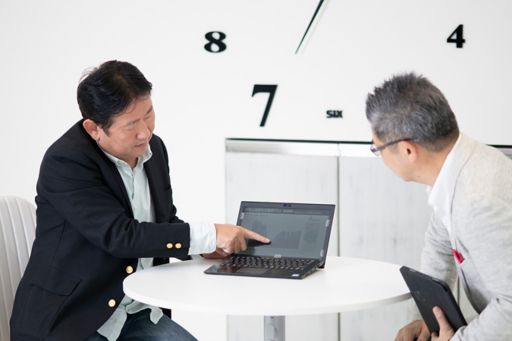
Chatani: Recently, when I was commuting by train, there seemed to be more people than before but this is compared to when the train was almost empty. We tend to forget how it was before the COVID-19 crisis. It is quite interesting to know that there is a divergence between data and how we feel.
Shibayama: You’re right. If we look at the actual data, the flow of people has not returned that much, as I mentioned earlier. For instance, the current congestion at Shinagawa Station is about the same as that at Kanazawa Station, which is a government-designated city in Ishikawa Prefecture, before the COVID-19 crisis. As congestion at the major stations in Tokyo was abnormally excessive in the first place, we can say that this situation has become normal due to COVID-19.
The fact that we can sense an increase while it is not actually increasing leads to the importance of data-driven management. It is important to recognize that “though we feel that things have gone back to the previous state, they have not, according to the data.”
Many things have already changed due to COVID-19.
Are distribution and retail businesses suffering a setback or is the restaurant business placed in a difficult position? Also, among the restaurants, which are more impacted, independently operated stores or chain stores? We must analyze these data or else we will fall behind the times and this will also determine our future. “Thinking about it next year” will be too late.
Good Time to Review Disaster Control Measures Based on Data
Chatani: Listening to your story about the drastic changes in trading areas, I began to feel that we need to review our disaster control measures as well.
As the flow of people during daytime and nighttime has changed, local disaster prevention plans should be revised as well. If there are more people in residential areas during the daytime than had been assumed before, isn’t it possible that shelters that are used in times of disaster will be overloaded?
Shibayama: I completely agree with you. Disaster prevention plans were originally created based on the information obtained through the national census. At the time of the Great East Japan Earthquake, plans had been made based on the estimate that “there should only be a few people in seaside areas during business hours,” in light of the results of the national census. However, there was a discrepancy with the actual situation, which resulted in the damage being substantially different.

It will be difficult to draw up disaster prevention plans based on the changes in the people-flow due to COVID-19 using statistical data such as the national census. Especially in the residential areas of large cities with houses made of wood that are closely built together, where many people were assumed to have gone to work, their disaster prevention plans must be changed, as “there is more risk of fire than of being stranded due to mass transit disruption”.
People-flow data are beginning to be utilized in disaster prevention plans now.
As the Great Hanshin Earthquake occurred early in the morning when breakfasts were being prepared, there was extensive fire damage, which led to many safety standards being reviewed. Likewise, all standards should be reviewed now.
The fact that they have not been reviewed is indicative of the issue of how data are valued and handled in Japan, including real-time people-flow data. I believe that we must change this immediately.
Profile of Interviewee
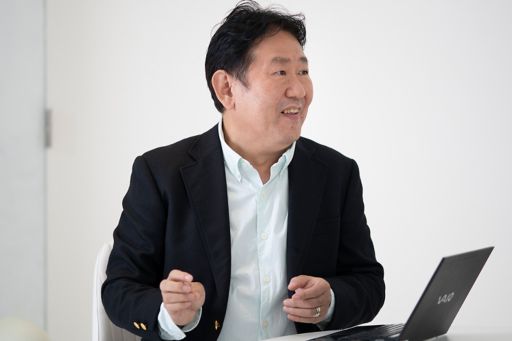
Kazuhisa Shibayama
President & CEO
Agoop Corp
Kazuhisa Shibayama joined former SoftBank BB Corp. in 2003, where he palnned and developed a data analysis system on top of “Geographical Information System (GIS).” Later in April 2009, he founded Agoop Corp. as SoftBank’s subsidiary company and became it’s director.
In 2012, he doubled as the Executive Manager of the Information Planning Supervisory Department at SoftBank Mobile Corp. (currently SoftBank Corp.), where he invented the world’s first network quality improvement system that utilizes location big data collected and analyzed from smartphones. The system had a significant contribution to the improvement of the mobile network of the former SoftBank Mobile Corp. He became the Representative Director of Agoop Corp. in 2013, and subsequently the General Manager of the Big Data Strategy Headquarters at SoftBank Corp. in 2015. In 2019, he assumed the position of President and CEO of Agoop Corp. as his main duty, while doubling as the Head of the Big Data Strategy Office of SoftBank Corp. Currently, he is carrying forward AI and RPA in the field of data science.
Follow us on KPMG Ignition Tokyo LinkedIn for the latest news.
Connect with us
- Find office locations kpmg.findOfficeLocations
- kpmg.emailUs
- Social media @ KPMG kpmg.socialMedia




